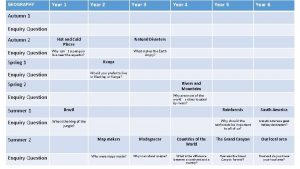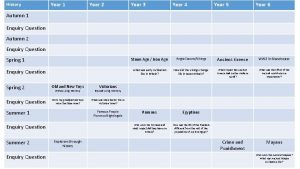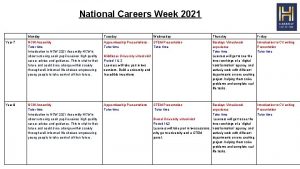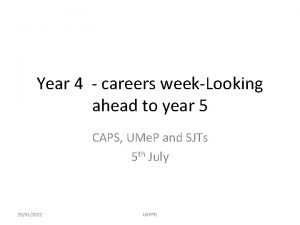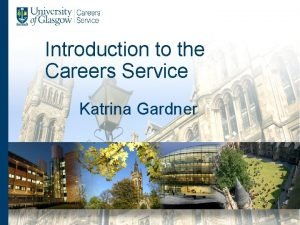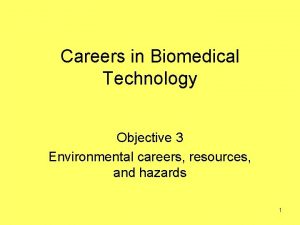Year 11 Careers Lesson 1 What are the



















- Slides: 19

Year 11 - Careers Lesson 1 What are the skills that employers look for?

• Hand out the sheet with the skills circle first (before the table) • Then hand out the booklet with the skills boxes for the students to: 1. write in the names of the skills next to the correct statements. 2. Write a STAR answer for each skill.

Over the next few careers lessons we will be looking at: 1. The skills that employers look for. 2. What type of personality you have and how this might influence that courses and jobs that you apply for. 3. Your interests – How you interests might influence the job or courses that you apply for. – How your extra-curricular interests will make you stand out against other candidates. Do you need to develop more interests (volunteering etc. ) 4. Use your interests, skills and personality information to research possible careers. Or, if you if already think that you know what to do, to start to plan how to get there!

The three areas that will help you to decide on possible courses and careers. Your possible career. Decide on some aims for the future If you want to secure a place on a course or be successful in an apprenticeship/job application, you must be able to demonstrate these three areas on your CV, in your covering letter, and at interview. Skills Personality Interests

Outcomes • Know the five top personal skills employers seek and five additional skill essential for success at work • Be able to describe each skill and why it is important • Be able to use the STAR technique to describe example of when you have demonstrated each skill

In pairs, note down as many of the different skills that you think employers are looking for Skills

Did you get these top 5 skills? Look at the table and the examples. Write each skill in the correct box in the first column to match with the correct examples in the second column

Write the correct skill that matches with the examples in this column

Did you get these top 5 skills? Look at the table and the examples. Write each skill in the correct box in the first column to match with the correct examples in the second column


Now you are going to write your STAR answers for when you have demonstrated each skill

You started to look at the STAR technique last year – but let’s quickly through it again. Lloyds Banking and many other major employers use this technique. IT WORKS!

THE "STAR" APPROACH STAR stands for: • • Situation Task Action Result. This is a recognised method of communication designed to enable you to provide a meaningful and complete answer to questions asking for examples. This technique allows you to provide information in a structured manner and, as a result, interviewers can understand the messages you are trying to communicate.

Step 1 – Situation Describe the situation that you were confronted with. With the STAR approach you need to set the story. Make it to the point and informative, concentrating on what is useful to the story. For example: if the question is asking you to describe a situation where you had to deal with a difficult person, explain briefly how you came to meet that person and why you were dealing with them.

Step 2 – Task Now you have set the scene by describing the situation, you should then explain the task that needed to be accomplished. Again remember you should keep this short and to the point, the interviewer may start to loose interest if you give too much detail. For example: when describing the situation where you had to deal with a difficult person, explain that you needed to make this person understand why a problem had occurred in the hope this would calm them down.

Step 3 – Action This is the most important section of the STAR approach as it is where you will need to demonstrate the skills and personal attributes that the question is testing. Now that you have set the story, you need to explain what you did. In doing so, you will need to remember the following: • Be personal, i. e. talk about you, not the rest of the team. • Go into some detail. Do not assume that they will guess what you mean. • Steer clear of technical information, unless it is crucial to your story. • Explain what you did, how you did it, and why you did it. Make sure you draw attention to the particular skills you used in this scenario and why you felt it was appropriate to use them. For example, you may want to describe how you used the team to achieve a particular goal and how you used your communication skills to keep everyone updated on progress etc.

Step 4 – Result Explain what happened eventually – how it all ended. Also, use the opportunity to describe what you accomplished and what you learnt in that situation. This helps you make the answer personal and enables you to highlight further skills.

Example answers to help you: Situation Task I entered a local marathon to raise money for my favourite charity. Having never run a race before and not I researched the best training methods being very fit, I had to get myself fit enough online to ensure I exercised safely without to complete the marathon. causing myself injury. Using my planning skills, I worked out a training time table to slowly increase the distances I would run over several months. By the time the race day arrived, I was fit and fully prepared to run the distance. I completed the marathon and was pleased with the time I achieved. I was on a boat out to sea when the engine suddenly cut out. There was no radio on board, my phone had no signal and sharks were circling the boat so I couldn’t swim to shore. I had to find a way to get back to shore, before the boat drifted further out to sea. I used my initiative by searching the boat, I found an emergency pack and in this were medical supplies and a flare. Being conscientious, I read through the instructions first and then set off the flare into the sky. A person onshore saw the flare and contacted the Coastguard who found me and towed the boat to shore. I was going on holiday and had just I had to think of a way of getting my reached the airport 2 hours away, when I passport brought to the airport before my realised I had left my passport at home, flight closed in 3 hours time. going back to get it would take 4 hours and I would miss the flight. I phoned my housemate and explained the situation; I asked him to get my passport and bring it to me at the airport. By delegating this task, I reduced the time it would take to get the passport by half. My housemate managed to get my passport to me within 2 hours. I was able to check in before the flight closed and had a great holiday. It was the final minute of my team’s football I was at the halfway line with the ball at my match, the score was 1 -1 and we needed to feet. In that moment there was no one to score to win the league. pass to and I had to put the ball in the back of the net to win the match. I quickly assessed the situation and noticed the goal keeper was at the edge of his box, leaving the goal open. Making a quick decision, I took aim and kicked the ball as hard as I could. The ball flew in the air, over the head of the goalkeeper and hit the underside of the bar before crossing the line – GOAL!!! We won the league. I was camping in the forest with my two friends. I had gone to the car to get a torch and when I returned a grizzly bear was attacking the tent with my friends trapped inside. Thinking quickly, I used my resourcefulness and grabbed the lids off two nearby metal bins. I started crashing them together as loudly as possible. This got the grizzly’s attention! With the bear following, I ran to the car and jumped in, I was safe. This gave my friends time to crawl out of the collapsed tent and run to the ranger station, locking the door behind them. By using teamwork, my friend and I walked up to the stage door where she pretended to faint. The security guards ran to help leaving the backstage door wide open, I sneaked in. I was able to stand in the shadows at the side of the stage until the set was over; as the band walked off stage I stopped the lead singer and got the autograph! I had to think of a way of distracting the bear to allow my friends to escape from the tent and run to safety. I was going the concert of my favourite band I had to find a way to sneak past security to and as my little sister was too young to go, I get backstage and get the autograph. promised her I would get the lead singer’s autograph for her. Action Result

Outcomes • Know the five top personal skills employers seek and five additional skill essential for success at work • Be able to describe each skill and why it is important • Be able to use the STAR technique to describe example of when you have demonstrated each skill
 Mikael ferm
Mikael ferm Last day of year 6 poem
Last day of year 6 poem Hình ảnh bộ gõ cơ thể búng tay
Hình ảnh bộ gõ cơ thể búng tay Lp html
Lp html Bổ thể
Bổ thể Tỉ lệ cơ thể trẻ em
Tỉ lệ cơ thể trẻ em Gấu đi như thế nào
Gấu đi như thế nào Tư thế worm breton
Tư thế worm breton Alleluia hat len nguoi oi
Alleluia hat len nguoi oi Kể tên các môn thể thao
Kể tên các môn thể thao Thế nào là hệ số cao nhất
Thế nào là hệ số cao nhất Các châu lục và đại dương trên thế giới
Các châu lục và đại dương trên thế giới Công thức tiính động năng
Công thức tiính động năng Trời xanh đây là của chúng ta thể thơ
Trời xanh đây là của chúng ta thể thơ Cách giải mật thư tọa độ
Cách giải mật thư tọa độ Làm thế nào để 102-1=99
Làm thế nào để 102-1=99 độ dài liên kết
độ dài liên kết Các châu lục và đại dương trên thế giới
Các châu lục và đại dương trên thế giới Thơ thất ngôn tứ tuyệt đường luật
Thơ thất ngôn tứ tuyệt đường luật Quá trình desamine hóa có thể tạo ra
Quá trình desamine hóa có thể tạo ra






















